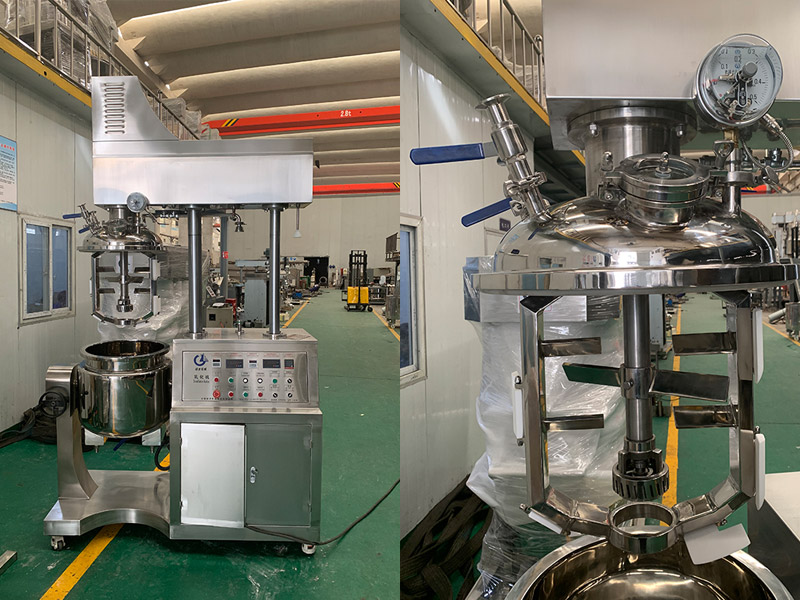From Nano to Micro: How High-Pressure Emulsifying Homogenizers Achieve Sub-Micron Particle Dispersion
The demand for ultra-fine particle dispersion in industries ranging from pharmaceuticals to advanced materials has driven the evolution of emulsifying homogenizers from macro-scale mixing to nanotechnology-enabled precision. High-pressure homogenization (HPH) has emerged as the gold standard for achieving sub-micron (≤1 μm) and even nano-scale (≤100 nm) particle sizes—a feat critical for enhancing bioavailability in drugs, stability in cosmetics, and performance in battery slurries. Among the pioneers in this field, Jiangsu GangBen Mixer Manufacturer has developed cutting-edge HPH systems that combine extreme pressure dynamics with intelligent control to address the limitations of traditional high-shear mixers.
The Science of Sub-Micron Dispersion: Why High-Pressure Homogenization?
Conventional rotor-stator mixers rely on mechanical shear to break down particles, but their efficacy plateaus at ~5–10 μm due to:
Limited shear intensity: Rotational speeds beyond 10,000 rpm risk cavitation and material degradation.
Uneven energy distribution: High-viscosity fluids often bypass the shear zone, leaving agglomerates intact.
Heat generation: Prolonged mixing at elevated temperatures destabilizes heat-sensitive formulations like proteins or lipids.
High-pressure homogenizers overcome these challenges by:
Forcing fluids through micro-channels: At pressures up to 1,500 bar (21,750 psi), liquid jets collide at supersonic speeds, generating turbulence and cavitation that shatter particles.
Uniform energy input: Every droplet or particle experiences identical stress, ensuring batch-to-batch consistency.
Minimal thermal impact: Process times are reduced to milliseconds, preserving formulation integrity.
Jiangsu GangBen’s Breakthrough: The GB-HP Series High-Pressure Homogenizers
Jiangsu GangBen’s GB-HP Series integrates proprietary technologies to push the boundaries of sub-micron dispersion:

1. Multi-Stage Valve Design for Adaptive Processing
Traditional homogenizers use fixed-gap valves, which struggle with varying material viscosities. The GB-HP’s self-adjusting ceramic valve dynamically modifies the orifice size based on real-time pressure feedback, maintaining optimal shear rates across:
Low-viscosity emulsions (e.g., O/W creams)
High-solid-content slurries (e.g., lithium-ion battery electrodes with 75% solid loading)
Fiber-reinforced composites (e.g., carbon nanotube dispersions)
Case Study: A leading Chinese vaccine manufacturer reduced adjuvant particle sizes from 8 μm to 0.3 μm using the GB-HP-2000, achieving a 40% increase in antigen adsorption efficiency.
2. Nano-Coated Interaction Chambers for Wear Resistance
At pressures exceeding 1,000 bar, abrasive particles erode metal surfaces, contaminating formulations and shortening equipment lifespan. Jiangsu GangBen addresses this with:
Tungsten carbide-lined chambers: Withstand abrasion from silica or titanium dioxide particles.
Diamond-like carbon (DLC) coatings: Reduce friction by 80%, enabling continuous operation at 1,200 bar without downtime.
3. AI-Powered Process Optimization
The GB-HP Series integrates IoT sensors and machine learning algorithms to:
Predict optimal pressure settings: Based on material properties (e.g., viscosity, pH) and desired particle size.
Auto-correct deviations: Compensate for pump wear or valve clogging in real time.
Generate compliance reports: Track pressure, temperature, and homogenization cycles for FDA/EMA audit trails.
Example: A Korean cosmetics brand used the GB-HP’s AI module to cut sunscreen formulation development time from 6 months to 6 weeks by eliminating trial-and-error parameter tuning.
Industry Applications: Where Sub-Micron Dispersion Matters
Pharmaceuticals:
Liposomal drug delivery systems require particles <200 nm to evade renal clearance. The GB-HP-500 achieves this in a single pass, reducing production costs by 60% compared to ultrasonic homogenization.
Food & Beverage:
Plant-based milk alternatives often suffer from gritty textures due to large fat globules. Jiangsu GangBen’s HPH systems reduce droplet sizes to 0.5 μm, matching the mouthfeel of dairy milk.
Energy Storage:
Solid-state battery electrolytes demand uniform dispersion of lithium salts (e.g., LiTFSI) to prevent dendrite formation. The GB-HP-1000 ensures sub-100 nm particle distribution, extending cell cycle life by 300%.
Challenges and Jiangsu GangBen’s Solutions
Energy Consumption: High-pressure systems traditionally consume 50–100 kW/h per ton. The GB-HP’s pulsation-free piston pump reduces energy use by 35% while maintaining stable pressure.
Maintenance Costs: Ceramic valves in competitive models cost 5,000+toreplaceannually.JiangsuGangBen’s∗∗modularvalvedesign∗∗allowsindividualcomponentreplacementat<1,200/year.
Scalability: Lab-scale HPH units
News
- Latest News
- Solutions
- FAQ
Recommend Products
-
 10L Vacuum Emulsifying Mixer
10L Vacuum Emulsifying Mixer10L Vacuum Emulsifying Mixer is a device used for emulsifying and mixing various substances in a vacuum environment. It is commonly used in industries such as food, cosmetics, and pharmaceuticals.
-
 20L Vacuum Emulsifying Mixer
20L Vacuum Emulsifying Mixer20L vacuum emulsifying mixer is a device used for emulsifying and mixing various substances in a vacuum environment. It has a larger capacity and is suitable for handling larger batches of materials.
-
 30L Emulsifying Homogenizer Mixer
30L Emulsifying Homogenizer Mixer30L Emulsifying Homogenizer Mixer is a high-speed emulsifying homogenizer mixer that is suitable for various emulsification and homogenization applications. It can be used to mix and emulsify various liquids, such as water, oil, and other liquids, to achieve a stable emulsion.
Recommend Faq
-
 Aug 07,2025
Aug 07,2025Vacuum Emulsifying Mixer for Toothpaste & Sunscreen: Shear Force & Temperature Control Technology
-
 Aug 07,2025
Aug 07,2025Energy Efficiency Redefined: Next-Gen Emulsifying Homogenizer Mixer Cut Power Consumption by 40%
-
 Jul 29,2025
Jul 29,2025How to Choose the Right Vacuum Emulsifying Mixer for Your Production Needs


 English
English Russian
Russian French
French Spanish
Spanish Portuguese
Portuguese Korean
Korean Japanese
Japanese Thai
Thai


